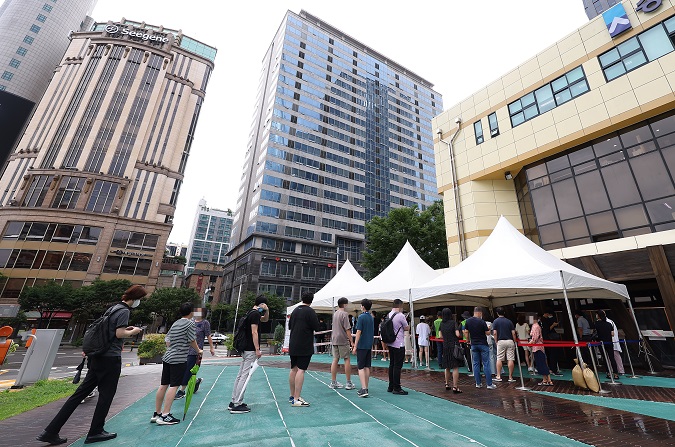
A traveler stands in front of a COVID-19 testing center at Incheon International Airport in Incheon, west of Seoul, on July 26, 2022. (Yonhap)
SEOUL, Aug. 2 (Korea Bizwire) — South Korea saw its total COVID-19 caseload rise above 20 million late Tuesday as a highly infectious omicron variant has fueled a surge of new infections.
As of 9 p.m., local governments had reported 115,311 additional cases, bringing the cumulative number to 20,047,750.
The nation, with a population of 51.6 million, reached the grim milestone 2 1/2 years after its first COVID-19 case was reported on Jan. 20, 2020.
The cumulative number surpassed 1 million on Feb. 5, 2022, 5 million on March 8, 10 million on March 22 and 15 million on April 8.
Tuesday’s number from midnight to 9 p.m. marked an increase of 8,944 from the same period of Monday and of 1.18 times the number from a week before.
It was the first time since April 18 that a 9 p.m. tally has exceeded 110,000.
Daily cases are counted until midnight and announced the following morning.
Earlier Tuesday, the Korea Disease Control and Prevention Agency (KDCA) announced 111,789 new COVID-19 infections, including 568 from overseas, were confirmed in the past day, bringing the total caseload to 19,932,439.
Daily cases tend to increase through the mid-week before falling again on weekends and Mondays on fewer tests.
The figure jumped from the previous day’s 44,689 and also increased from the 99,252 cases reported a week ago, driven by the fast spread of the omicron variant BA.5, which had become dominant among South Korean cases at 66.8 percent as of Tuesday.
Earlier in the day, the country confirmed two more COVID-19 cases of BA.2.75, a new, fast-spreading omicron subvariant, taking the total such cases to nine.
The two people, both fully vaccinated and boosted once, returned to South Korea after visiting India last month. They suffered mild symptoms and are now fully recovered, the KDCA said.

People stand in line to take coronavirus tests at a screening clinic in Seoul’s Songpa Ward on Aug. 1, 2022. (Yonhap)
Eased COVID-19 entry rules and a sharp rise in summer travelers led to record numbers of infection cases from overseas. Import cases, which have stayed in the triple digits since June 24, hit an all-time high of 568 on Tuesday.
The highly transmissible omicron variant also caused a fresh wave of hospitalizations, with serious cases reaching the highest levels in nearly three months.
The number of seriously ill COVID-19 patients was 282 on Tuesday, down five cases from a day earlier when the figure rose to the highest after May 18, when the tally stood at 313.
The KDCA reported 16 deaths from COVID-19, raising the death toll to 25,084. The fatality rate was 0.13 percent.
Health authorities said the current wave could peak at around 200,000 infection cases a day, a level that is lower than previously expected and deemed manageable.
The government has said it was not considering reimposing stringent social distancing rules to fight the resurgent virus in a firm resolve to continue to move on from the pandemic and resume normal activities.
For the week ended on July 30, the average daily caseload came in at 79,490, up 31 percent from the previous week. But the reproduction rate decreased 0.25 to 1.29 from a week earlier, according to the KDCA.
(Yonhap)






